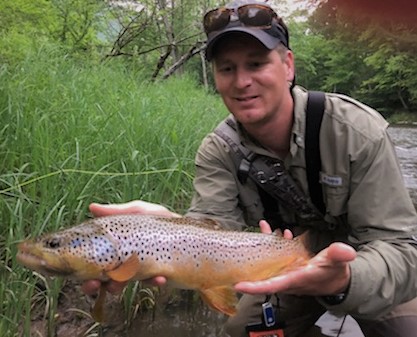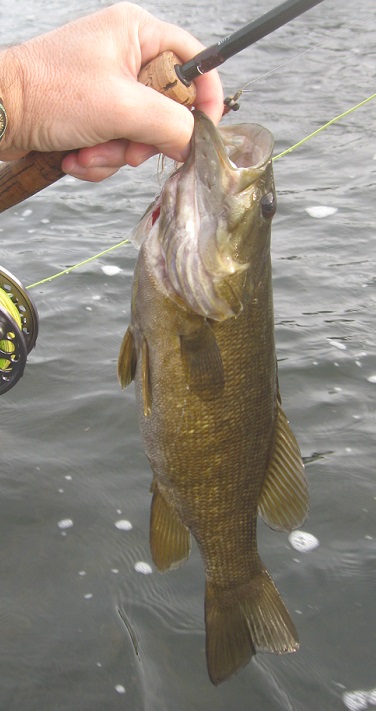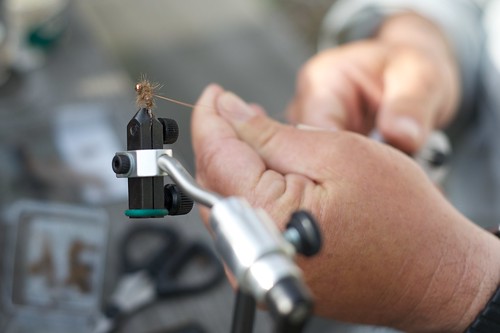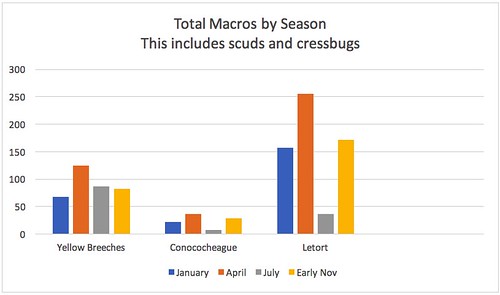You are using an out of date browser. It may not display this or other websites correctly.
You should upgrade or use an alternative browser.
You should upgrade or use an alternative browser.
Dave_W
Blue Liner Flows Review | USGS Stream Gauges
Jun 18
- 273
- 2
All water level data originates from the United States Geological Survey (USGS) Surface-Water Data, which monitors over 13,000 stream gauges across the U.S. and more than 350 in Pennsylvania. The USGS has been transitioning to a new online interface over the past five-plus years. The updated look and feel have left some old features behind while adding new ones. I hate it.
So, I’ve been on the hunt for a desktop and mobile app that delivers USGS backend data through a clean, easy-to-use interface. Blue Liner Flows offers a solid solution for iPhone, iPad and Mac users, with apps built for both platforms. Most importantly, favorites and preferences sync across devices. There’s a free version, but I’ll be reviewing the $6.99 annual paid version.
Key features include: favorites, state selection, map view, latest data overview, discharge in CFS, discharge in feet, average annual discharge, various time views, weather forecasts, alerts, temperatures (station-dependent), turbidity (station-dependent), and other data specific to each gauge.
I found the app very easy to set up on my Mac. Once configured, all my favorites and alerts synced automatically to my iPhone. You don’t need both devices—an iPhone alone works just fine. I especially liked navigating between the state, favorites, and map views. It’s fast and intuitive. Most views display the key information I’m looking for, including directional arrows indicating whether water levels are rising or falling.
[ATTACH type="full" width="720px"...
Cicada Flies - Some Thoughts and Observations
Jan 03
- 2,075
- 10
By Dave Weaver
With the brood prevalent in central PA emerging this year, it's an auspicious time to tie up some cicada patterns.
I have fished the brood that emerges in SCPA/MD in 1987, 2004, and 2021 and took careful notes on emergence and fishing results. If you have never fished one of these 17 year broods, it's an amazing, sometimes frustrating, experience. Generally, it has been my observation that the bugs are not evenly spread across the regions indicated on emergence maps. Instead, they seem to emerge in great clusters here and there. You can expect to find them very dense on a section of stream, and a half mile up or downstream, there are none. Some sections with bugs see heavy fish feeding and other sections they seem to be ignored. You will have to explore and improvise.
For the 2021 brood, I tied up a large batch of cicada flies in anticipation. As is my preference, I used foam. These 17 year cicadas are different than the typical annual cicadas that are green over white. Instead, 17 yr bugs are smaller and black or dark gray with orange legs, orange abdominal ribbing, and clear wings with an orange tint. Their body length is about 1 to 1.25" so I tied my flies in that size on somewhat long shank nymph/streamer hooks that matched the body size. I secured the body to the shank using glue and orange floss as ribbing, much like a big hopper fly or a pencil popper. This was a mistake.
I had trouble with these flies when the hatch started as the hookup ratio was very poor. Curiously, I found that fallfish were getting hooked as they were more deliberate in taking the fly, mostly coming up from behind and inhaling the rear of the fly. Trout, by contrast, tended to be much more aggressive, often charging from the side blowing up on the fly or simply slashing it, and not getting hooked. There were days when it seemed like I only hooked maybe one in ten trout...
YOUTH CAMP FLIES - THANK YOU
Jun 14
- 1,634
- 0
 To the fly tiers of PAFF, a hearty thank you for your efforts in supporting the Rivers Conservation and Fly Fishing Youth Camp. I had put in a request for fly donations (original thread) and many of you donated your time and materials to produce some excellent flies. The camp director, upon receiving the flies, was very appreciative, calling them a "game changer," as donations were lower this year.
To the fly tiers of PAFF, a hearty thank you for your efforts in supporting the Rivers Conservation and Fly Fishing Youth Camp. I had put in a request for fly donations (original thread) and many of you donated your time and materials to produce some excellent flies. The camp director, upon receiving the flies, was very appreciative, calling them a "game changer," as donations were lower this year. The students will be meeting soon on the Yellow Breeches and will put the flies to good use. The youth camp was conceived by Jack Beck of Cumberland Valley Trout Unlimited who pondered why America had all sorts of youth camps for various sports and other activities, but not cold water conservation. Today, the CVTU youth camp sets the standard for a variety of similarly themed youth camps and puts teenagers in hands-on activities including building stream improvement structures, fly tying and macro-invertebrate study. In the mornings and evenings, the students get to apply what they learned by fly fishing on Yellow Breeches.
Thanks,
Dave_W
Multi Species in the Autumn Transition Zone
Sep 11
- 1,080
- 0
Large Pennsylvania streams and rivers in October and November can provide an interesting grab bag of fish that might munch our flies, and big weedless streamers are the way to go. For many Pennsylvania fly fishermen, October and November are months when they return to stream trout fishing, if they ever left. In particular, years such as this one magnify this effect as we have spent what seems like many months waiting for rain and cooler temperatures and are especially eager to get back out for trout. Some fly fishers gave the river bass game a go-round during summer, but soon are back on trout streams as the days get shorter and colder. Few die hard fly fishers stick with bass by late October. Try checking out a mid- sized or larger bass river in late October: a fly fisher is a rare sight.
Spin fishers, by contrast, know that late autumn fishes well on the big rivers. Bass are still active and walleyes, pike, and muskies are on the prowl. In addition, many of the larger streams and mid-sized rivers have transient populations of large, wild brown trout in the “transition zone” – that is to say the lower reaches of what normally passes for trout water (or where it is stocked) that transitions into a warm water fishery. These fish drop back downriver during the autumn, or migrate out into rivers from colder tributaries. To be sure, these trout are hard to find, cagy, often nocturnal even in colder periods, and are a specialized game. Nevertheless, they are part of the mix. Some very large browns fall to spin guys fishing tubes and swimming plugs for bass and walleyes during the colder months here in Pennsylvania every year.
[url=https://www.flickr.com/gp/alhazen/722935...
The Small Warm Water Stream Summer Game
Jul 04
- 1,133
- 0
Mid summer into mid autumn is prime time for small stream, warm water fly fishing. While this summer (2018) has, so far, been unseasonably wet and cool here in southcentral Pennsylvania, mid-June has traditionally been the time I start to look to local creeks for bass and panfish. The main game are smallmouth bass, rock bass, and red-breast sunfish. Many of these creeks also have largemouth bass, carp, fallfish, green sunfish, bluegills, hatchery trout, crappies, even pickerel and walleyes. However, red-breasts, rockies, and smallies are prevalent in most of the creeks I fish, with red-breasts ruling the roost. Green sunfish are equally widespread and sometimes are present in numbers best described as swarms, but they’re generally too small to target.
Many fly fishers, if they’re not focused entirely on trout fishing, look forward to the summer bass fishing season. Wading or boating the Susquehanna or other bigger waters is indeed a great experience, but many of these anglers overlook the little local creeks close to home. While the rivers are a motivating place to fish in summer, if you don’t live near one, or otherwise are waiting for levels to drop and clear, something that can take several days after small streams have cleared, don’t overlook warm water creeks close to home. Most of these streams I frequent are typically twenty to fifty feet wide and comparable to what I’d consider medium sized trout creeks that one would fish with a 4WT.
Many of these streams are downstream sections of Approved Trout Waters. Agricultural valley streams can be productive too. Some are tributaries of bigger rivers and may play a role in bass spawning in springtime. One thing to note about access: land owners whose properties these creeks traverse, are often less familiar with anglers on their property as...
Many fly fishers, if they’re not focused entirely on trout fishing, look forward to the summer bass fishing season. Wading or boating the Susquehanna or other bigger waters is indeed a great experience, but many of these anglers overlook the little local creeks close to home. While the rivers are a motivating place to fish in summer, if you don’t live near one, or otherwise are waiting for levels to drop and clear, something that can take several days after small streams have cleared, don’t overlook warm water creeks close to home. Most of these streams I frequent are typically twenty to fifty feet wide and comparable to what I’d consider medium sized trout creeks that one would fish with a 4WT.
Many of these streams are downstream sections of Approved Trout Waters. Agricultural valley streams can be productive too. Some are tributaries of bigger rivers and may play a role in bass spawning in springtime. One thing to note about access: land owners whose properties these creeks traverse, are often less familiar with anglers on their property as...
In Memoriam: Ed Shenk
Apr 13
- 1,449
- 0
In sad news for the fly-fishing community and the Cumberland Valley in particular, Ed Shenk passed away this week. He was 93.
Ed was one of the last of a well-known generation of Pennsylvania fly fishing innovators from the Greatest Generation. He is often mentioned in the same breath with Charlie Fox, Vince Marinaro, and other central Pennsylvania fly fishers who were central to advancing the sport in the mid-twentieth century. Like Fox and Marinaro, Shenk is best known for his association with the Letort, our state’s best-known stream for the development of innovative fishing methods.
Many of us knew Ed and fished with him. While he could be opinionated, Ed was always willing to help and was eager to share his knowledge and experience. An innovative fly tier, Ed has long been associated with a variety of well known and still productive patterns, in particular the Letort Hopper, Letort Cricket, Shenk Sculpin, and Shenk’s White Minnow among others.
He was a guru of short fly rods and was handy at building custom glass rods. This short rod school has made a lasting impression on many of us who still love to fish with rods under six feet long, almost a sort of rebellion against the new fad for longer rods.
Ed was particularly skilled at targeting large trout with streamers, sculpin patterns in particular. This too affected many of us. I remember an article by Ed, “Sculpinating Trout” from (I think) Fly Fisherman Magazine in the mid-1980s. When I recently told Ed that that article had hooked me on sculpins, still one of my favorite flies, he was delighted and surprised someone would remember an article from back then.
Ed published a book, Fly Rod Trouting (Stackpole, 1989) that should be in any Pennsylvania...
Ed was one of the last of a well-known generation of Pennsylvania fly fishing innovators from the Greatest Generation. He is often mentioned in the same breath with Charlie Fox, Vince Marinaro, and other central Pennsylvania fly fishers who were central to advancing the sport in the mid-twentieth century. Like Fox and Marinaro, Shenk is best known for his association with the Letort, our state’s best-known stream for the development of innovative fishing methods.
Many of us knew Ed and fished with him. While he could be opinionated, Ed was always willing to help and was eager to share his knowledge and experience. An innovative fly tier, Ed has long been associated with a variety of well known and still productive patterns, in particular the Letort Hopper, Letort Cricket, Shenk Sculpin, and Shenk’s White Minnow among others.
He was a guru of short fly rods and was handy at building custom glass rods. This short rod school has made a lasting impression on many of us who still love to fish with rods under six feet long, almost a sort of rebellion against the new fad for longer rods.
Ed was particularly skilled at targeting large trout with streamers, sculpin patterns in particular. This too affected many of us. I remember an article by Ed, “Sculpinating Trout” from (I think) Fly Fisherman Magazine in the mid-1980s. When I recently told Ed that that article had hooked me on sculpins, still one of my favorite flies, he was delighted and surprised someone would remember an article from back then.
Ed published a book, Fly Rod Trouting (Stackpole, 1989) that should be in any Pennsylvania...
The Paflyfish Top Trout Award – 2018
Sep 07
- 936
- 0
We see so many photos of impressive trout caught across Pennsylvania and nearby states every year. Some we know where they came from and what fly they took, and others are more mysterious. Mostly, they’re wild brown and brook trout. Some of these fish are impressive due to their size and others are real lookers with beautiful colors; some are especially impressive based on where they came from as certain streams have cachet as tough streams with few large trout.
I have long felt that PAFF should identify a “top trout” on an annual basis from the photos submitted throughout the year. We’ve discussed it among the moderator staff over the years. So, for 2019, I’m keeping an eye on some especially impressive fish posted to this site. At the end of the year, the “winner” and some runners-up will be identified by the moderator staff. In the meantime, I have canvassed the pics from last year and we have selected a final group of five particularly impressive fish. From these, we have selected a winner.




So (cue the drum roll), the Top Trout for 2018 was submitted to the site by Nightstalker – a magnificent brown trout caught on a streamer (Below). Of course, the decision was tough. Runners-up (Above) included a large brook trout submitted by Salvalinusfontinalis, another large brookie submitted by Mowgoli84. 3wt7X submitted a big brown caught by a friend from Penns, and Nymph-wristed submitted a beautiful wild brown that, although it wasn’t the unicorn he hooked, was still a “pig.” These were all top fish in their own right and worthy to be remembered by a Pennsylvania fly fisher as a fish of a lifetime.
[img...
I have long felt that PAFF should identify a “top trout” on an annual basis from the photos submitted throughout the year. We’ve discussed it among the moderator staff over the years. So, for 2019, I’m keeping an eye on some especially impressive fish posted to this site. At the end of the year, the “winner” and some runners-up will be identified by the moderator staff. In the meantime, I have canvassed the pics from last year and we have selected a final group of five particularly impressive fish. From these, we have selected a winner.




So (cue the drum roll), the Top Trout for 2018 was submitted to the site by Nightstalker – a magnificent brown trout caught on a streamer (Below). Of course, the decision was tough. Runners-up (Above) included a large brook trout submitted by Salvalinusfontinalis, another large brookie submitted by Mowgoli84. 3wt7X submitted a big brown caught by a friend from Penns, and Nymph-wristed submitted a beautiful wild brown that, although it wasn’t the unicorn he hooked, was still a “pig.” These were all top fish in their own right and worthy to be remembered by a Pennsylvania fly fisher as a fish of a lifetime.
[img...
2018 PAFF Eastern PA Fly Tying Jam: 17 Feb
Jan 28
- 625
- 0
You are invited to attend and participate in the 2018 PAFF Eastern PA Fly Tying Jamboree, to be held on Saturday, February 17, from 10 AM to 5 PM.
This event is being hosted by Michael Lohman GenCon and Rich Mooney, Mooney4. Either of us will answer any questions regarding the event.
This event will be held at the Lehigh Gap Nature Center, in Slatington, PA. Directions can be found here: http://lgnc.org/
Everyone is invited to attend and watch the demonstrations, get tips from the the tyers, and have a great time. We particularly encourage beginner tyers to attend, and we'll have beginner instruction set up at a table. Details to follow.
As always, we need to recruit a team of volunteer tyers of all skill levels to participate and we ask that you register your willingness to give a demonstration by signing up in this thread. Each tyer will be given 15-20 minutes to tie and explain their chosen demo fly. Tyers will tie one at a time, proceeding around the room. Please choose a pattern that fits in to one of the following categories, and list it in your signup post. Duplicates are OK, but try to pick a pattern that hasn't already been chosen.
Categories:
- Catskill style dries
- parachute style dries
- comparadun and hairwing style dries
- emergers
- imitative nymphs
- attractor nymphs
- terrestrials
- wet flies
- streamers
- "other" flies
Tying on a large hook (e.g. #12) makes it much easier for the audience to see what you are doing. It really helps if you practice your "demo" beforehand, especially to keep within the time limit. Having all materials laid out beforehand is also good. We should be able to fit about 30 tyers into the rotation. If we have extra time, that time will be used for Q & A sessions following each demo. We request...
This event is being hosted by Michael Lohman GenCon and Rich Mooney, Mooney4. Either of us will answer any questions regarding the event.
This event will be held at the Lehigh Gap Nature Center, in Slatington, PA. Directions can be found here: http://lgnc.org/
Everyone is invited to attend and watch the demonstrations, get tips from the the tyers, and have a great time. We particularly encourage beginner tyers to attend, and we'll have beginner instruction set up at a table. Details to follow.
As always, we need to recruit a team of volunteer tyers of all skill levels to participate and we ask that you register your willingness to give a demonstration by signing up in this thread. Each tyer will be given 15-20 minutes to tie and explain their chosen demo fly. Tyers will tie one at a time, proceeding around the room. Please choose a pattern that fits in to one of the following categories, and list it in your signup post. Duplicates are OK, but try to pick a pattern that hasn't already been chosen.
Categories:
- Catskill style dries
- parachute style dries
- comparadun and hairwing style dries
- emergers
- imitative nymphs
- attractor nymphs
- terrestrials
- wet flies
- streamers
- "other" flies
Tying on a large hook (e.g. #12) makes it much easier for the audience to see what you are doing. It really helps if you practice your "demo" beforehand, especially to keep within the time limit. Having all materials laid out beforehand is also good. We should be able to fit about 30 tyers into the rotation. If we have extra time, that time will be used for Q & A sessions following each demo. We request...
Macroinvertebrate Survey Through the Seasons
Nov 16
- 845
- 0
The chart below includes the total number of all macroinvertebrates in seine. The July sample in Letort may have been impacted by dense weeds producing a reduced number.
This survey sought to identify macroinvertebrate populations in three different central PA stream types over the course of a year for the purpose of shedding light on nymph populations that might be of interest to fly fishermen. Three streams were chosen reflecting a freestone stream (Conococheague), a semi-limestoner (Yellow Breeches), and a limestoner (Letort).
I attempted to ensure that each kick seine survey was done in as close to the exact spot in the riffle each time I conducted the survey. These surveys were done in January, April, July, and early November. Although I don’t claim that this effort was entirely scientific, the results do shed some light on nymph numbers and characteristics. Moreover, the results bear out fly fishing conventional wisdom: that nymphs are more numerous and larger in springtime. In all three streams, the macro biomass was highest in April. The graph above reveals the fluctuation in the riffle by season. Of note, the Letort far exceeded the other streams in total biomass, although as one would expect, this difference was largely due to scuds and cress bugs. If one were to break out scuds and cress bugs from Letort, the number of nymphs would have been less than Conococheague. If you’re a limestone stream nympher, Letort in particular, scud and cress bug patterns are well known for a reason.
Among general observations of the streams’ combined results that I think merit note are a couple things:
1. The relative scarcity of stoneflies and caddis compared to the much more numerous mayflies.
2. The generally small size of these nymphs throughout the seasons, but especially in summer and...
This survey sought to identify macroinvertebrate populations in three different central PA stream types over the course of a year for the purpose of shedding light on nymph populations that might be of interest to fly fishermen. Three streams were chosen reflecting a freestone stream (Conococheague), a semi-limestoner (Yellow Breeches), and a limestoner (Letort).
I attempted to ensure that each kick seine survey was done in as close to the exact spot in the riffle each time I conducted the survey. These surveys were done in January, April, July, and early November. Although I don’t claim that this effort was entirely scientific, the results do shed some light on nymph numbers and characteristics. Moreover, the results bear out fly fishing conventional wisdom: that nymphs are more numerous and larger in springtime. In all three streams, the macro biomass was highest in April. The graph above reveals the fluctuation in the riffle by season. Of note, the Letort far exceeded the other streams in total biomass, although as one would expect, this difference was largely due to scuds and cress bugs. If one were to break out scuds and cress bugs from Letort, the number of nymphs would have been less than Conococheague. If you’re a limestone stream nympher, Letort in particular, scud and cress bug patterns are well known for a reason.
Among general observations of the streams’ combined results that I think merit note are a couple things:
1. The relative scarcity of stoneflies and caddis compared to the much more numerous mayflies.
2. The generally small size of these nymphs throughout the seasons, but especially in summer and...
Stream Report for Susquehanna River on Oct. 21, 2017
Oct 31
- 583
- 0
Susquehanna River, Lancaster Co., 10/21/17
WEATHER: Blue bird skies with highs in the 70s.
WATER: 3.2' at the Harrisburg gauge, gin clear, 60 degrees. A few boaters and yakkers but not a lot of activity.
HATCHES ETC: Nothing significant. A few scattered bugs, no rises; large schools of small minnows around 2" in length around shoreline areas. No crayfish seen. One bass caught in a riffle today had multiple caddis larva in his mouth and gullet. These caddis were dark colored and about #16.
Teamed up with Afishinado today to put some autumn hurtin on the Susky bass.
We arrived at mid day about 11am and fished until 5:30pm. It was a tough day. The bright sun and very clear water seemed to have the river switched off. We fished some very good sections with little success. Around 4pm, with the sun lower in the sky and softened by haze, the river seemed to wake up. We found active fish in fast water, mostly along current seams but also in shallow riffles. I had expected to find SMBs around ledge rock and and deeper tailouts today, but these spots didn't produce. The active fish were in pretty fast water. Had luck high sticking a helgy nymph and swinging a Clouser. I tried poppers briefly with no success. I managed about eight fish with three in the mid teens. Afish got fifteen bass with one at 18 inches.
A very nice day to be outside, but fishing was sub-par for what I'd expect on the big river in October. Nevertheless, with water levels still quite low, if you're a wading angler, the Susky is in great shape for FFing right now.
Members can follow along with comments in the forum here.
WEATHER: Blue bird skies with highs in the 70s.
WATER: 3.2' at the Harrisburg gauge, gin clear, 60 degrees. A few boaters and yakkers but not a lot of activity.
HATCHES ETC: Nothing significant. A few scattered bugs, no rises; large schools of small minnows around 2" in length around shoreline areas. No crayfish seen. One bass caught in a riffle today had multiple caddis larva in his mouth and gullet. These caddis were dark colored and about #16.
Teamed up with Afishinado today to put some autumn hurtin on the Susky bass.
We arrived at mid day about 11am and fished until 5:30pm. It was a tough day. The bright sun and very clear water seemed to have the river switched off. We fished some very good sections with little success. Around 4pm, with the sun lower in the sky and softened by haze, the river seemed to wake up. We found active fish in fast water, mostly along current seams but also in shallow riffles. I had expected to find SMBs around ledge rock and and deeper tailouts today, but these spots didn't produce. The active fish were in pretty fast water. Had luck high sticking a helgy nymph and swinging a Clouser. I tried poppers briefly with no success. I managed about eight fish with three in the mid teens. Afish got fifteen bass with one at 18 inches.
A very nice day to be outside, but fishing was sub-par for what I'd expect on the big river in October. Nevertheless, with water levels still quite low, if you're a wading angler, the Susky is in great shape for FFing right now.
Members can follow along with comments in the forum here.
"
 >
>







